
Electrical safety company Atkore (NYSE:ATKR) met Wall Street’s revenue expectations in Q2 CY2025, but sales fell by 10.6% year on year to $735 million. Its non-GAAP profit of $1.63 per share was 3.2% above analysts’ consensus estimates.
Is now the time to buy Atkore? Find out by accessing our full research report, it’s free.
Atkore (ATKR) Q2 CY2025 Highlights:
- Revenue: $735 million vs analyst estimates of $738.6 million (10.6% year-on-year decline, in line)
- Adjusted EPS: $1.63 vs analyst estimates of $1.58 (3.2% beat)
- Adjusted EBITDA: $99.92 million vs analyst estimates of $99.85 million (13.6% margin, in line)
- Management raised its full-year Adjusted EPS guidance to $6.50 at the midpoint, a 3.2% increase
- EBITDA guidance for the full year is $400 million at the midpoint, below analyst estimates of $404.9 million
- Operating Margin: 8.7%, down from 20.5% in the same quarter last year
- Free Cash Flow Margin: 1.4%, down from 8.9% in the same quarter last year
- Market Capitalization: $2.58 billion
“Atkore delivered another strong quarter of financial results, achieving Net Sales, Adjusted EBITDA and Adjusted EPS towards the top end of the ranges we presented during our last earnings call in May,” commented Bill Waltz, Atkore’s President and Chief Executive Officer.
Company Overview
Protecting the things that power our world, Atkore (NYSE:ATKR) designs and manufactures electrical safety products.
Revenue Growth
A company’s long-term sales performance is one signal of its overall quality. Any business can put up a good quarter or two, but many enduring ones grow for years. Over the last five years, Atkore grew its sales at a solid 10% compounded annual growth rate. Its growth beat the average industrials company and shows its offerings resonate with customers.
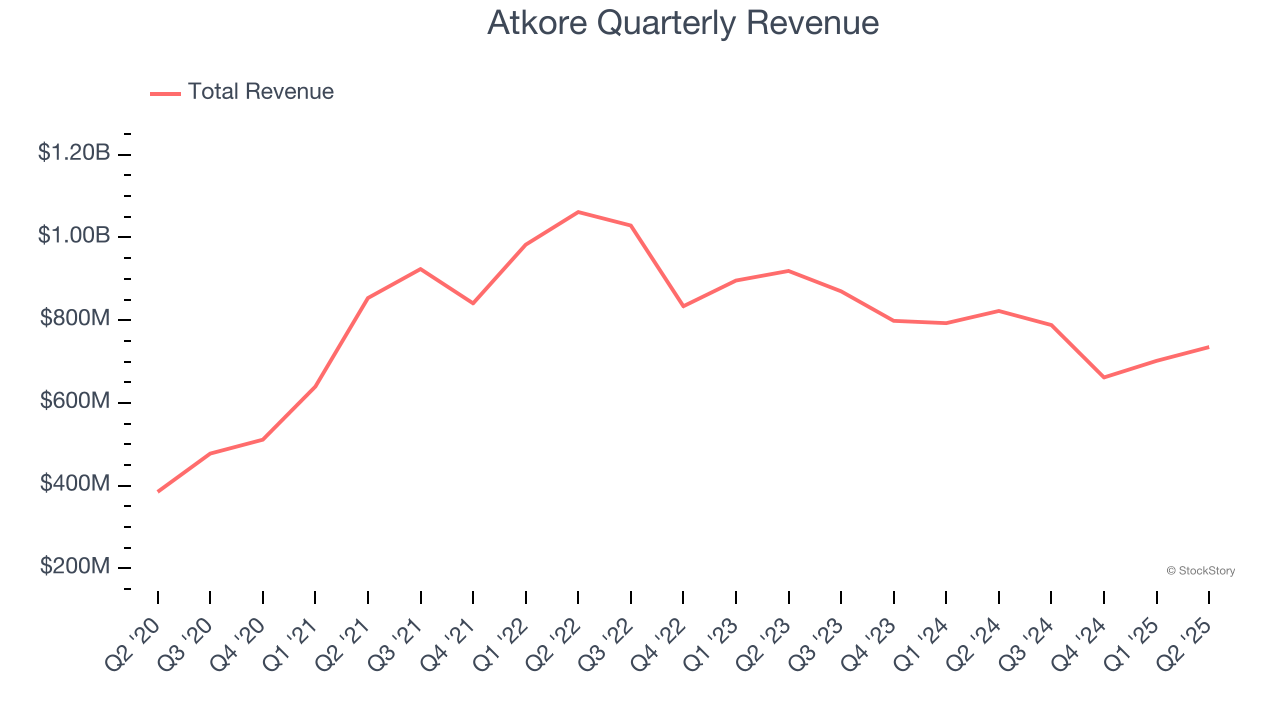
We at StockStory place the most emphasis on long-term growth, but within industrials, a half-decade historical view may miss cycles, industry trends, or a company capitalizing on catalysts such as a new contract win or a successful product line. Atkore’s recent performance marks a sharp pivot from its five-year trend as its revenue has shown annualized declines of 11.4% over the last two years. Atkore isn’t alone in its struggles as the Electrical Systems industry experienced a cyclical downturn, with many similar businesses observing lower sales at this time. 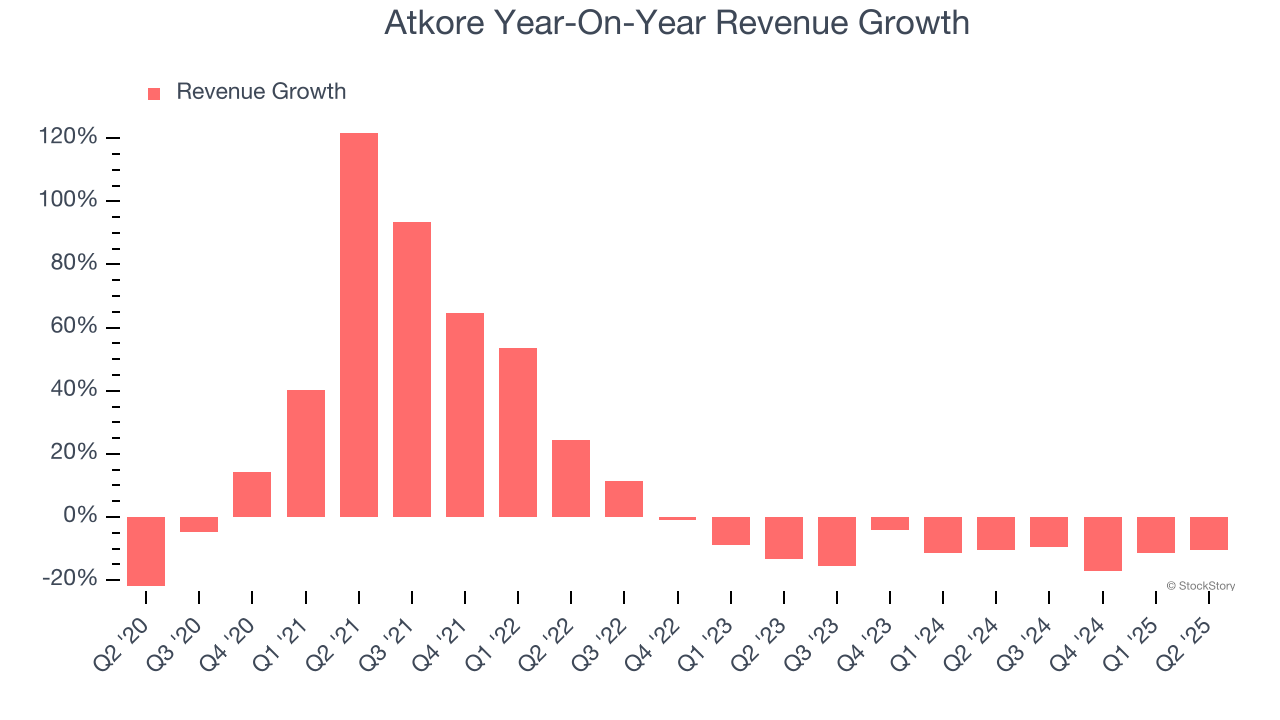
This quarter, Atkore reported a rather uninspiring 10.6% year-on-year revenue decline to $735 million of revenue, in line with Wall Street’s estimates.
Looking ahead, sell-side analysts expect revenue to grow 1.4% over the next 12 months. Although this projection suggests its newer products and services will fuel better top-line performance, it is still below the sector average.
Today’s young investors won’t have read the timeless lessons in Gorilla Game: Picking Winners In High Technology because it was written more than 20 years ago when Microsoft and Apple were first establishing their supremacy. But if we apply the same principles, then enterprise software stocks leveraging their own generative AI capabilities may well be the Gorillas of the future. So, in that spirit, we are excited to present our Special Free Report on a profitable, fast-growing enterprise software stock that is already riding the automation wave and looking to catch the generative AI next.
Operating Margin
Atkore has been a well-oiled machine over the last five years. It demonstrated elite profitability for an industrials business, boasting an average operating margin of 23%. This result isn’t surprising as its high gross margin gives it a favorable starting point.
Analyzing the trend in its profitability, Atkore’s operating margin decreased by 18.6 percentage points over the last five years. This raises questions about the company’s expense base because its revenue growth should have given it leverage on its fixed costs, resulting in better economies of scale and profitability.
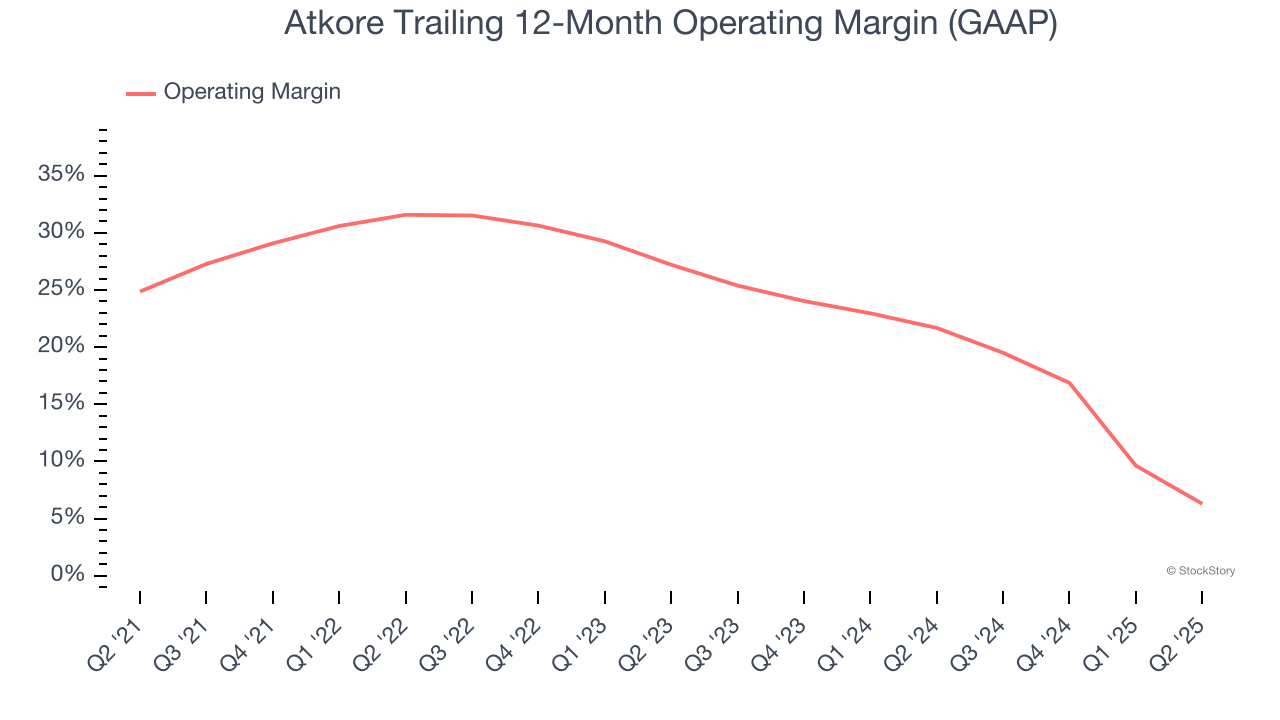
This quarter, Atkore generated an operating margin profit margin of 8.7%, down 11.8 percentage points year on year. Since Atkore’s operating margin decreased more than its gross margin, we can assume it was less efficient because expenses such as marketing, R&D, and administrative overhead increased.
Earnings Per Share
Revenue trends explain a company’s historical growth, but the long-term change in earnings per share (EPS) points to the profitability of that growth – for example, a company could inflate its sales through excessive spending on advertising and promotions.
Atkore’s EPS grew at a spectacular 16.4% compounded annual growth rate over the last five years, higher than its 10% annualized revenue growth. However, this alone doesn’t tell us much about its business quality because its operating margin didn’t improve.
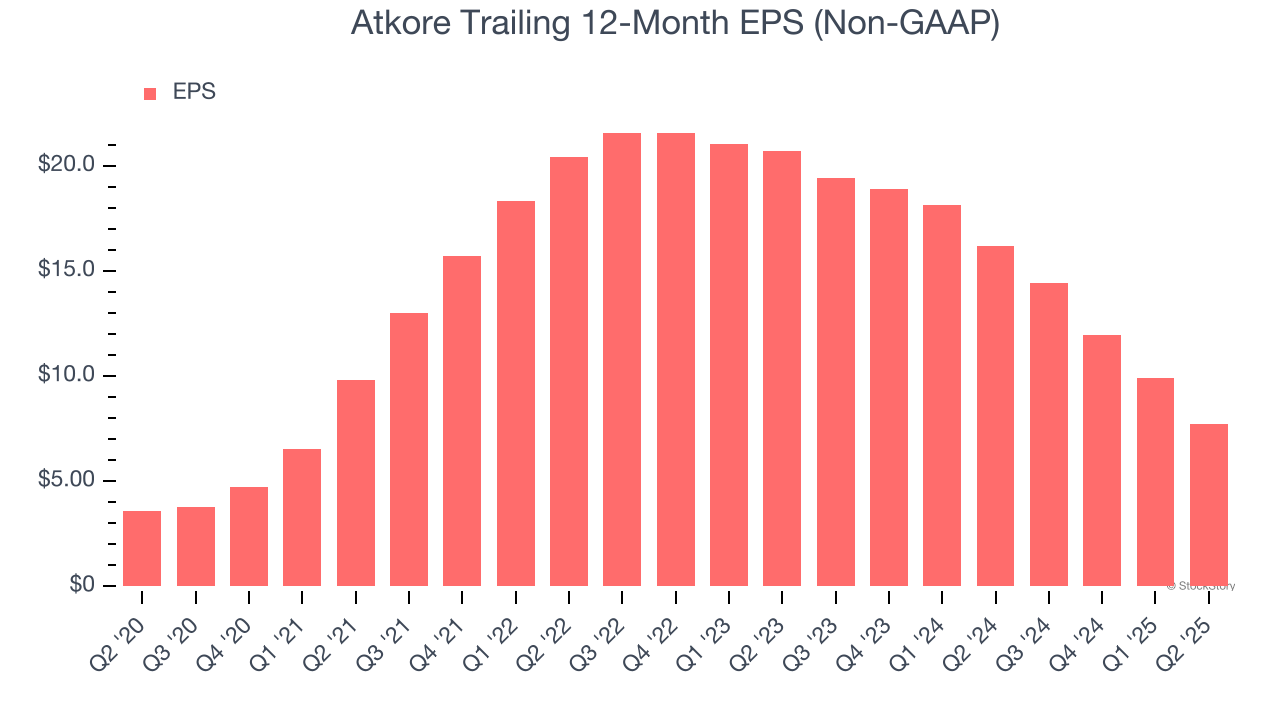
We can take a deeper look into Atkore’s earnings to better understand the drivers of its performance. A five-year view shows that Atkore has repurchased its stock, shrinking its share count by 29.2%. This tells us its EPS outperformed its revenue not because of increased operational efficiency but financial engineering, as buybacks boost per share earnings. 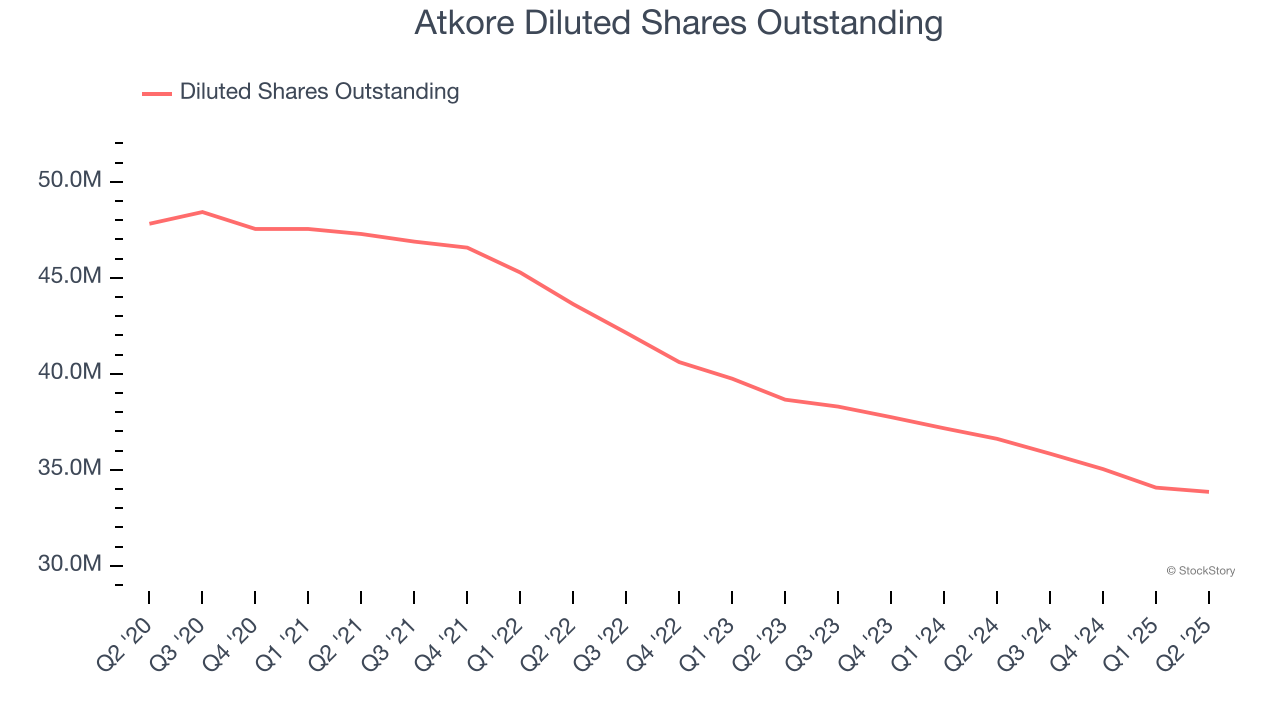
Like with revenue, we analyze EPS over a more recent period because it can provide insight into an emerging theme or development for the business.
For Atkore, its two-year annual EPS declines of 38.9% mark a reversal from its (seemingly) healthy five-year trend. We hope Atkore can return to earnings growth in the future.
In Q2, Atkore reported adjusted EPS at $1.63, down from $3.80 in the same quarter last year. Despite falling year on year, this print beat analysts’ estimates by 3.2%. Over the next 12 months, Wall Street expects Atkore’s full-year EPS of $7.73 to shrink by 19.9%.
Key Takeaways from Atkore’s Q2 Results
It was encouraging to see Atkore beat analysts’ EPS expectations this quarter. On the other hand, its full-year EBITDA guidance slightly missed and its revenue was in line with Wall Street’s estimates. Overall, this quarter could have been better. The stock traded down 3.2% to $74.09 immediately following the results.
Atkore’s latest earnings report disappointed. One quarter doesn’t define a company’s quality, so let’s explore whether the stock is a buy at the current price. The latest quarter does matter, but not nearly as much as longer-term fundamentals and valuation, when deciding if the stock is a buy. We cover that in our actionable full research report which you can read here, it’s free.
